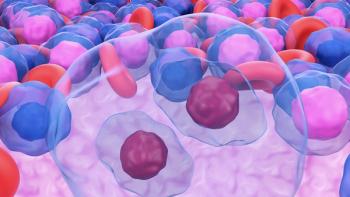
Predicting The Benefits Of Immunotherapy in NSCLC
Looking at biomarkers PD-L1 and TMB in tandem can help predict a patient with NSCLC reaction to immunotherapy.
Ongoing research is examining how the biomarkers PD-L1 and tumor mutational burden (TMB) can be used in a complementary fashion to predict which patients with advanced non—small cell lung cancer (NSCLC) will benefit most from immunotherapy.
“Now, nearly every trial evaluating checkpoint inhibitors incorporates biomarkers to some degree to look for responses and clinical benefit,” said James Herman, MD, co-director, Lung Cancer Program, professor of medicine, Department of Medicine, University of Pittsburgh. “PD-L1 has been incorporated into nearly every trial to assess where patients benefit most, and now increasingly, TMB is looked at as well. Most trials are incorporating one or both of these biomarkers to determine benefit among patient subgroups.”
In an interview with OncLive®, a sister publication to Oncology Nursing News®, Herman, who is also a medical oncologist at the University of Pittsburgh Medical Center Hillman Cancer Center, discussed the work that has been done to elucidate biomarkers of response to immunotherapy and the necessity of molecular testing at diagnosis.
OncLive®: Could you discuss the work that has been done to identify biomarkers of response to immunotherapy?
Herman: Immunotherapy has become a central part of most of our treatments for patients with lung cancer in the first- and second-line second settings. Trying to predict who will benefit most from immunotherapy is an ongoing process. [In my presentation,] I discussed PD-L1 staining, which is the ligand for checkpoint inhibition, as well as TMB, and how these could be used to select patients for therapy or determine who will benefit most from single-agent or combination immunotherapy.
What makes PD-L1 a good biomarker in lung cancer?
In terms of checkpoint inhibitors, PD-L1 is a good biomarker because it's the target for anti—PD-1/anti–PD-L1 therapies. These agents have shown clinical efficacy in lung cancer. It’s logical to look for the presence of the marker for that pathway engagement and it has proven to be quite useful in determining who will benefit most from checkpoint inhibitors.
Do liquid biopsies have a role in detecting these biomarkers?
Liquid biopsies are still in the discovery phase of determining their utility for immune-based therapies. They're exploratory at this point. However, they’re well established in the targeted space with EGFR, ALK, ROS, and BRAF [alterations].
When should patients undergo molecular testing?
Molecular testing for nearly all patients with NSCLC is important, especially for those with adenocarcinomas where we have a greater chance of finding actionable mutations. We want to identify targetable mutations first because [targeted therapies] provide great options for many patients. [We have to order] molecular testing upfront in order to look for actionable mutations, and then subsequently upon disease progression, to look for resistance mutations; [the latter of which] has become standard practice.
In terms of immunotherapy, PD-L1 testing is very useful in most settings. In the first-line setting, it allows us to select patients for single-agent immunotherapy. In other settings, it may be helpful in determining the relative benefit [of treatment] but it is not always necessary to [determine which treatment to prescribe].
What is the key takeaway regarding biomarkers of response to immunotherapy?
PD-L1 testing has been well established as a way to look for patients who may benefit from PD-1 therapies alone. With regard to combination therapies, such as chemotherapy and radiation, or chemotherapy and immunotherapy, [PD-L1] may provide some information about who will benefit most. However, so far, [PD-L1] does not provide enough information to exclude patients from those approaches. TMB remains interesting. There are suggestions that it may provide additional information about who will benefit from immune-based therapies, but at present, it has not been shown to be predictive enough to include or exclude patients for these therapies.
A version of this article originally appeared on OncLive® as, “
Newsletter
Knowledge is power. Don’t miss the most recent breakthroughs in cancer care.
















































































